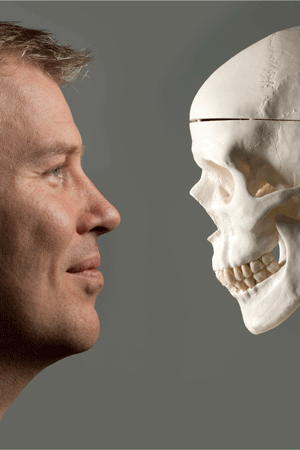A ground-breaking research project focusing on estimating facial characteristics based on DNA can, in time, aid patients with mental disorders and help to solve crimes.
Recognizing faces has always held a fascination for Jens Fagertun. This fascination has now become a research project aimed at improving so-called machine learning algorithms that make it possible to reproduce the human ability to assess complex data on computers. The research forms part of Jens Fagertun’s PhD project.
“The vision is to gain an understanding of a person’s facial appearance based on facial DNA. To date, we have shown that it is possible to predict several facial components using genetic data and we’re now able to predict simple archetypes.
“Although this doesn’t mean we can print out a picture of a criminal, we are convinced that it will become possible at some point in the future to go from the DNA to an understanding of the person’s facial features. However, there are limits to what we can see. The environment a person grows up in also plays a part in their facial appearance.
What made you opt for facial recognition?
“I started my PhD because I was fascinated by facial recognition. It’s something we all use to make sense of life’s daily interactions—both at and outside of work. We are all semi-experts in facial recognition. That’s why it was fascinating to get a computer to do the same.”
Benefiting doctors and the police
The research may provide doctors at psychiatric hospitals with an alternative tool—3D facial scanning—to identify patients at risk of developing mental disorders. The DNA samples can thus help doctors to better assess the degree of risk a patient has for developing mental disorders such as schizophrenia.
The research may also help the police to more effectively narrow down the field of suspects from a crime scene where there is DNA evidence. The aim is to use DNA traces to predict facial characteristics that provide the basis for criminal sketches.
Further research required
The research project is a so-called ‘proof-of-concept’ study in which Jens Fagertun has worked with DNA samples from more than 1,000 subjects. The next step is to secure further funding for facial analysis and genetics research to improve understanding of the statistical possibilities.
According to Jens Fagertun, the technique will in all probability be used within the next few decades:
“It’s difficult to quantify the project perspectives. It will depend on the accuracy of our predictions. The studies increase our knowledge about which parts of our DNA relate to the face and which DNA genes relate to disease and bone development. It’s fascinating—also at global level—as only a handful of articles exist on the understanding between DNA and facial recognition. In this sense, we are doing groundbreaking research.”
 |
|
Estimating facial characteristics
In order to estimate facial characteristics, Jens Fagertun has developed statistical models of the DNA and facial characteristics. He has then attempted to determine which DNA structures relate to which facial characteristics.
In addition to the statistical models, Jens Fagertun has also conducted research into which DNA points affect how the simpler human understanding of facial distances develops—and which doctors and people generally find it easy to relate to.
|